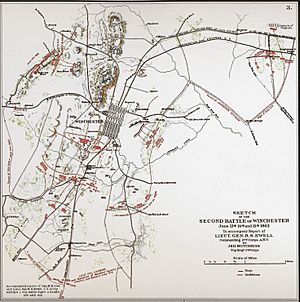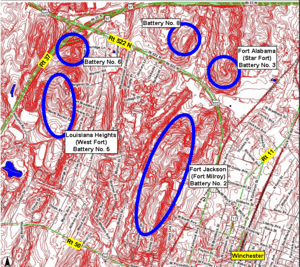Second Battle of Winchester facts for kids
Quick facts for kids Second Battle of Winchester |
|||||||
|---|---|---|---|---|---|---|---|
| Part of the American Civil War | |||||||
 Sketch of the Second Battle of Winchester, by Jedediah Hotchkiss. |
|||||||
|
|||||||
| Belligerents | |||||||
| Commanders and leaders | |||||||
| Robert H. Milroy | Richard S. Ewell | ||||||
| Units involved | |||||||
| 2nd Division, VIII Corps | Second Corps, Army of Northern Virginia | ||||||
| Strength | |||||||
| 7,000 | 12,500 | ||||||
| Casualties and losses | |||||||
| 4,443
(95 killed
348 wounded 4,000 missing or captured) |
269
(47 killed
219 wounded 3 missing) |
||||||
The Second Battle of Winchester was a big fight during the American Civil War. It happened from June 13 to June 15, 1863, in Frederick County and Winchester, Virginia. This battle was part of the Gettysburg Campaign.
During this battle, Confederate Lieutenant General Richard S. Ewell led his troops north. They were moving through the Shenandoah Valley towards Pennsylvania. Ewell's army defeated the Union Army soldiers defending Winchester. These Union soldiers were led by Major General Robert H. Milroy. The Confederates captured Winchester and took many Union soldiers as prisoners.
Contents
Why the Battle Happened
After another battle called Battle of Brandy Station on June 9, 1863, Confederate General Robert E. Lee gave an order. He told Ewell's 19,000 soldiers to clear out any Union forces in the lower Shenandoah Valley. This was so Lee's main army could move into Pennsylvania. The Blue Ridge Mountains would hide them from Union attacks.
Union General Henry Halleck was worried about how his army was protecting the Baltimore and Ohio Railroad. He thought the plan to keep soldiers at places like Winchester was not good. He believed it would be hard to hold Winchester against a large enemy force.
Who Fought in the Battle
Confederate Forces: Ewell's Second Corps
Lieutenant General Richard S. Ewell commanded about 19,000 Confederate soldiers. His army was made up of several divisions:
- Major General Jubal A. Early's division.
- Major General Robert E. Rodes's division.
- Major General Edward "Allegheny" Johnson's division.
- They also had a special 1st Maryland Battalion and cavalry led by Brig. Gen. Albert G. Jenkins.
Union Forces: Milroy's 2nd Division
Major General Robert H. Milroy led about 6,900 Union soldiers. His force included three infantry brigades. These were led by Brig. Gen. Washington L. Elliot and Colonels Andrew T. McReynolds and William G. Ely. There were also two small outposts northwest of town.
Moving Towards Battle
Confederate Army's Plan
General Lee wanted to move his army across the Potomac River into Pennsylvania. He planned to use the Blue Ridge Mountains to hide his movements. This big move started on June 3.
Ewell's Second Corps was a key part of this plan. They marched from June 4 to June 11, moving closer to the Shenandoah Valley. On June 11, Ewell met with his generals to plan how to capture Winchester and Martinsburg.
On June 12, Ewell decided to split his army into two groups:
- Northern Group: Rodes's Division and Jenkins's cavalry went north through Berryville, Virginia to Martinsburg, West Virginia. Their goal was to capture Union soldiers at Berryville and then push on to Martinsburg.
- Main Attack Group: Early's Division and Johnson's Division went northwest towards Winchester, Virginia. Their goal was to attack the forts and Milroy's soldiers in Winchester.
By the end of June 12, Ewell's troops were in position for the attack.
Union Army's Defenses
Outposts and Scouting
Milroy had soldiers stationed at Berryville to watch for Confederates. He also had guards around Winchester. However, these guards were too close to the town. This meant Milroy didn't know much about what was happening far away. His soldiers had also suffered heavy losses trying to stop Confederate cavalry raids.
Strong Forts in Winchester
Winchester had many strong forts and defenses around it. Milroy had built or improved ten forts, numbered 1 to 10. These forts were connected by roads and trenches. Milroy believed these strong defenses and his long-range cannons would allow him to hold out for a long time.
During the battle, Milroy focused his soldiers in three main forts on the ridges west of town:
- Fort Milroy (Battery No. 2): This was the biggest fort, with 14 cannons.
- Star Fort (Battery No. 3): This fort had 8 cannons.
- West Fort (Battery No. 5): This was a smaller fort with 4 cannons.
Milroy also used other smaller forts at first, but later abandoned them.
The Main Battle Begins
June 13: First Fights
Ewell's Attack Plan
Ewell and his generals knew the area around Winchester well from earlier battles. They decided to attack Milroy's forces from two sides:
- West Attack: Early's Division would go west, then north, to approach Winchester from the southwest and west.
- East Attack: Johnson's Division would go northwest on the Front Royal Pike. They would make noise and fight to distract the Union soldiers from Early's main attack.
Confederate Divisions Advance
Johnson's division moved first, pushing back Union guards at the Opequon River. They fought some small cavalry battles. Johnson's advance slowed down when Fort Milroy's big cannons fired at them.
Early's division moved west, then north. They also met Union soldiers and pushed them back.
Milroy Pulls Back to His Forts
Milroy still didn't realize he was facing a huge part of Lee's army. He gathered all his soldiers into the three main forts. General Halleck had told Milroy to leave Winchester and go to Harpers Ferry. But Milroy thought his forts were strong enough to hold out.
Confederates Cut Off Escape Routes
Ewell had planned to block Milroy's escape. Rodes's Division went to Martinsburg through Berryville. They tried to capture a Union brigade at Berryville, but those soldiers escaped to Winchester. However, the Confederates did capture Union supplies and 75 prisoners. They also cut the telegraph line to Winchester, so Milroy couldn't communicate with anyone. By the end of June 13, Rodes's Division had captured Martinsburg and five Union cannons. That night, a big rainstorm hit the area.
June 14: Ewell's Double Attack
Early's Sneaky Move
On June 14, Early's soldiers captured Bower's Hill easily. Early and Ewell then decided on a sneaky plan. Early took three of his brigades and 20 cannons on a hidden march. They went west, out of sight of the Union forts, then north. While Early was moving, Johnson's soldiers kept fighting to distract the Union forces. Confederate cannons on Bower's Hill also fired at Fort Milroy.
By mid-afternoon, Early's forces were in position opposite West Fort. They had 20 cannons ready to fire. Inside the Union forts, Milroy and his officers thought they had pushed back the Confederates. They didn't know they were completely surrounded.
Early Attacks West Fort
Around 6 p.m., Early's cannons opened fire on West Fort. They fired for 45 minutes. While this was happening, Hays's Louisiana brigade quietly moved through fields. Then, they rushed forward across 300 yards of open ground and stormed the fort. After a short fight, the Union defenders left the fort and ran to Fort Milroy. The Confederates then turned the captured Union cannons around and used them against the Union soldiers. It got dark, stopping further fighting, but cannons kept firing for a long time. Ewell later named West Fort Ridge "Louisiana Heights" to honor Hays's brigade.
Johnson Blocks Escape Routes
Ewell thought Milroy might try to escape during the night. So, he ordered Johnson to march north and block any escape to the east-north-east. Around 9 p.m., Johnson's soldiers began a night march towards Stephenson's Depot. This was a train stop near where the Martinsburg Pike and Charles Town Road met.
Milroy Tries to Escape
Also at 9 p.m., Milroy and his officers decided to try to "cut their way through" to Harpers Ferry. They planned to use the old Charles Town Road, which was the same road Johnson's soldiers were marching to block. The Union soldiers destroyed their cannons and left their forts very quietly. They moved towards the Charles Town crossroad, just south of Stephenson's Depot.
June 15: Johnson's Final Attack
Near dawn on June 15, Johnson's soldiers met Milroy's retreating column near Stephenson's Depot. Milroy's soldiers prepared to fight their way out. Johnson quickly set up his soldiers and cannons. As it got lighter, Union soldiers made several desperate attacks to break through, but the Confederates held their ground. Finally, a Confederate brigade crushed the last Union attack. Other Confederate soldiers then moved to cut off the Valley Pike. This was the end for the Union soldiers. Many raised white flags to surrender. Milroy's horse was shot, and his division scattered. Some small groups managed to escape to Union-controlled areas.
After the Battle
Battle Results
The battle was a huge victory for the Confederates. Ewell reported capturing 23 cannons, 4,000 prisoners, 300 loaded wagons, and many horses and supplies. The Union army reported 4,443 total casualties, including 95 killed, 348 wounded, and 4,000 missing or captured. The Confederates had only 269 casualties. This was a very one-sided battle.
Milroy and about 1,200 of his soldiers managed to escape to Harpers Ferry. However, Milroy's command was effectively destroyed. He was later arrested. The Confederates gained many valuable supplies, including enough cannons and horses to equip new units.
President Abraham Lincoln later wrote to Milroy, saying he never doubted Milroy's bravery. But he also said Milroy often complained about his superiors. Lincoln believed this was why Milroy had problems. Milroy was later cleared of wrongdoing. He even claimed his defense of Winchester helped cause the Battle of Gettysburg, which the Union won. However, General Halleck made sure Milroy was not given another command.
How it Helped Lee's Campaign
The victory at Second Winchester cleared the Shenandoah Valley of Union troops. This opened the way for Lee's second invasion of the North. Capturing so many supplies also helped Lee's plan to feed his army as they marched. The Union defeat shocked the North. The Secretary of War asked for more soldiers, and President Lincoln asked for 100,000 volunteers. News of the Confederate advance spread quickly, causing Pennsylvania's governor to call for 50,000 volunteers to protect his state.
Ewell's Next Steps
After the battle, Ewell sent his cavalry to Chambersburg, Pennsylvania, to find food and scout the area. Ewell moved his headquarters near Winchester. The captured flag from Fort Milroy was used to make a new Confederate flag. The fort itself was renamed "Fort Jackson" to honor the recently deceased former Confederate commander.
Important Leadership
Jubal Early showed great leadership in this battle. General Lee later trusted Early so much that he gave him command of the Confederate Second Corps. Early even managed to shell Washington, D.C., in 1864, something Lee had tried to do twice before.
Medals of Honor
Three Union soldiers received the Medal of Honor for their brave actions during the Second Battle of Winchester:
- 2nd Lt. James R. Durham, 12th West Virginia Infantry
- Musician John T. Patterson, 122nd Ohio Infantry
- Pvt. Elbridge Robinson, 122nd Ohio Infantry


